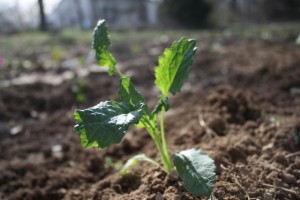This year we are trying out several new additions to the Spring CSA, including this delicious kale variety. Lacinato Kale is also known as black kale, Tuscan kale, cavolo nero, or dinosaur kale. It was one of the plants grown for Thomas Jefferson in the vegetable gardens at Monticello, making it one of the oldest plant varieties in our garden this year. It is also grown in Italy, and is a traditional ingredient in the Tuscan soup ribollita.

In the garden, lacinato kale can grow up to three feet tall. The leaves are bumpy (like dinosaur skin–hence the name dinosaur kale), and are usually harvested from the bottom up over the course of the growing season. As an heirloom variety, it thrives without the use of modern industrial fertilizers and pesticides. When you cook it, the bumps in the leaves help to hold pan juices, giving you bursts of flavor with each bite.
Lacinato kale has a flavor that is slightly more delicate than its curly or Russian cousins. You can use it in soup like ribollita (literally: reboiled), or you can eat it grilled, boiled, stuffed, roasted (mmmm… kale chips!) or–our favorite–partly blanched and sauteed with garlic, red pepper, and olive oil. It is gentle enough to eat raw in a salad, but holds its own even a lasagna or casserole.
This is one that you will probably not see at your local supermarket, and that you may not see from other farms around Memphis. In April and May when the baby green garlic and kale are both coming in–look out! You might get so spoiled that supermarket food just won’t do. If you haven’t signed up for the Spring CSA yet, check it out and get in before we run out of space!
